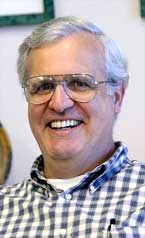
Handy Links
SLAC News Center
SLAC Today
- Subscribe
- Archives: Feb 2006-May 20, 2011
- Archives: May 23, 2011 and later
- Submit Feedback or Story Ideas
- About SLAC Today
SLAC News
Lab News
- Interactions
- Lightsources.org
- ILC NewsLine
- Int'l Science Grid This Week
- Fermilab Today
- Berkeley Lab News
- @brookhaven TODAY
- DOE Pulse
- CERN Courier
- DESY inForm
- US / LHC
SLAC Links
- Emergency
- Safety
- Policy Repository
- Site Entry Form

- Site Maps
- M & O Review
- Computing Status & Calendar
- SLAC Colloquium
- SLACspeak
- SLACspace
- SLAC Logo
- Café Menu
- Flea Market
- Web E-mail
- Marguerite Shuttle
- Discount Commuter Passes
-
Award Reporting Form
- SPIRES
- SciDoc
- Activity Groups
- Library
Stanford
Around the Bay
From the Acting Director of SSRL: A Successful 2010 User Run

It is that time of year again at the Stanford Synchrotron Radiation Lightsource when the SPEAR3 storage ring shuts down, the users pack up and go home to analyze their data, and the support staff gear up for a busy period of upgrades and much needed maintenance activities as well as some well-deserved rest.
At the risk of repeating my column from last year, 2010 has been a great year for SSRL operations. We ran for the first time in true top-off mode, in which the current was kept constant in SPEAR3 by frequent (every 10 minute) injections. This mode of operation was approved for routine use only in June. The users have been extremely pleased with this operating mode—no more interruption of scans to wait for the injection to take place, and a 20 percent higher intensity since the beam is no longer allowed to decay for eight hours before filling. This mode of operation puts severe constraints on the reliability of all the SPEAR3 systems since the injector system must run continuously—any errors show up as a missed fill, which is evident on the beam current display. The occasional missed fill does not adversely affect the users. The goal of zero missed fills comes from a sense of pride from the operations staff and probably a few side-bets.
The accelerator uptime was 95.5 percent this year primarily due to a Booster Klystron problem earlier in the year; however, during the last month of the run, the typical up time was 100 percent. It is also interesting to note that the overall system (accelerator plus beam lines) had a mean time between failure of 88 hours, and 150 hours for the accelerator alone, which is excellent.
On the beamline side, twenty-seven stations were operating this year—two more than last year, which should contribute to a higher user count. Exciting experiments continue to be performed ranging from elucidating the nature of the H1N1 influenza virus to understanding how fuel cell efficiencies can be improved via atomic level engineering, or discovering the feather and bone chemistry of the Archaeopteryx. This is only a small snapshot of the research being carried out by the approximately 1400 unique users who have come to SSRL this year.
This year has also seen the addition of important new detector capabilities, including a large Pilatus 6M Pixel Array Detector and data acquisition system for the Beamline 12-1 macromolecular crystallography station, which will greatly enhance the throughput and accuracy of the structure determinations, as well as a unique 100-element germanium detector array for X-ray absorption spectroscopy, which provides greatly enhanced sensitivities. We have also started exploring the world of the ultrafast via picosecond X-ray pulses produced by SPEAR3 in "low alpha" mode, which will provide a bridge to the even faster femtosecond pulses of the Linac Coherent Light Source. Additional connections to LCLS have been forged both on the administrative side, through the sharing of a common user administration and safety group, as well as the experimental side, where the chamber used at LCLS for the SXR experiment was first tested on Beamline 13-1 at SSRL.
As SSRL shutdown activity ramps up to high gear, numerous accelerator, infrastructure and beamline capability and reliability upgrades will be completed, getting us ready to come up in the fall at 350 mA, effectively doubling the integrated current that SSRL users saw when the run started in the fall of 2009. This is an important milestone along the path of realizing the full 500 mA operating current potential of SPEAR3. Once we gain experience at 350 mA and assure ourselves that the user data quality is maintained at the higher currents, we'll be ready to take the next step up, sometime during the coming run year.
It should be emphasized that none of this could happen without the hard work and, most importantly, teamwork of all the staff across the SLAC site and I would like to take this opportunity to give my heartfelt thanks.
